January 16, 2025 · 13 min read
Streamlining Compliance and Audit Meetings in Healthcare Institutions

Shaimaa Badawi
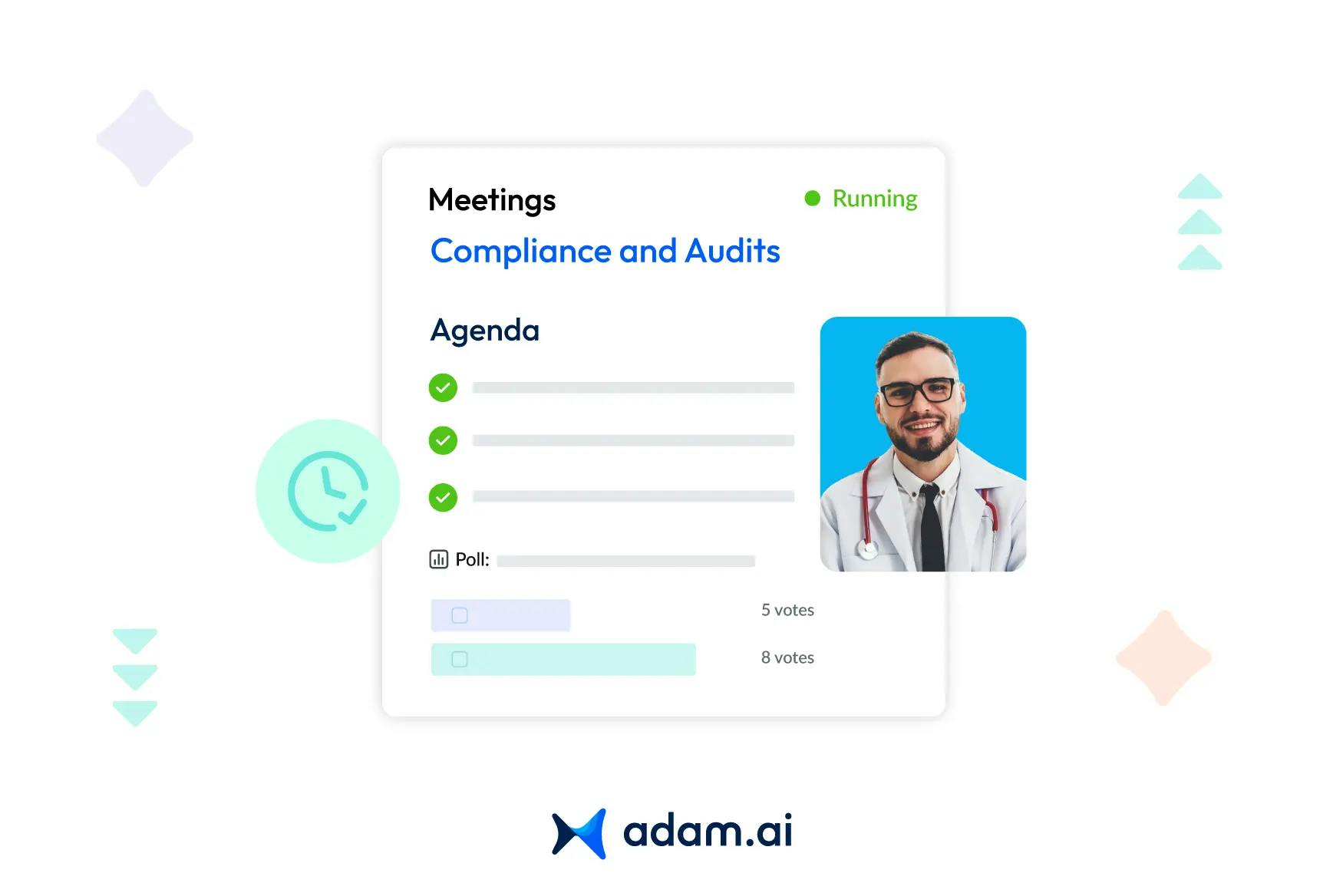
Compliance and audit meetings are vital for ensuring patient safety, data security, and regulatory adherence in healthcare. Yet, the complexity of regulations and the critical nature of healthcare operations can make these meetings challenging. This article explores practical strategies to streamline compliance and audit meetings and highlights how key features can transform these sessions into powerful tools for organizational improvement.
What are the main challenges healthcare institutions face in compliance and audit management?
Healthcare institutions face several challenges in managing compliance and audits due to the complexity of regulations, the criticality of patient data, and the high stakes involved. Below are some of the main challenges:
- Evolving regulatory landscape
Healthcare is one of the most heavily regulated industries, with requirements constantly changing. Keeping up with frameworks like HIPAA, HITECH, GDPR, and CMS guidelines is daunting. Frequent updates can lead to gaps in compliance if organizations fail to adapt quickly. - Data security and privacy risks
With healthcare institutions managing sensitive patient-protected health information (PHI), ensuring data security is critical. The rise of cyberattacks, ransomware, and insider threats has made protecting PHI more challenging, especially in hybrid and multi-cloud environments where data is scattered across systems. - Resource constraints
Many healthcare organizations struggle with limited budgets, staff shortages, and the lack of specialized compliance officers. These resource constraints make it difficult to allocate adequate attention to compliance management and audits. - Complex IT infrastructure
Modern healthcare organizations operate with diverse IT systems, including electronic health records (EHRs), billing systems, and clinical databases. Ensuring compliance across interconnected, multivendor platforms while avoiding vulnerabilities is a significant challenge. - Time-intensive manual processes
Compliance audits often rely on manual processes for data collection, documentation, and reporting. This not only consumes time but also increases the risk of human error, creating inefficiencies and potentially missed regulatory deadlines. - Lack of training and awareness
Staff often lack adequate training on compliance protocols or are unaware of the latest regulations. This can lead to non-compliance, especially when dealing with new standards or technologies. - Balancing efficiency with compliance
Healthcare organizations must balance operational efficiency with rigorous compliance requirements. Streamlining workflows while ensuring adherence to regulatory standards often becomes a delicate trade-off. - Audit fatigue
Frequent audits, both internal and external, can overwhelm staff and drain resources. Repeated audits without automated systems can lead to burnout and reduced accuracy in compliance efforts. - Ineffective communication across teams
Compliance and audit success depend on collaboration across multiple departments. Siloed teams, poor communication, and lack of centralized reporting systems can create bottlenecks and increase the likelihood of non-compliance. - Reputation and financial risks
Failing compliance audits can result in hefty fines, legal action, and reputational damage. This creates pressure to maintain perfect audit readiness, which can divert focus from improving healthcare services.
Why is regulatory compliance critical for healthcare organizations?
Regulatory compliance is essential for healthcare organizations as it safeguards patient safety, ensures data security, maintains ethical standards, and protects institutions from legal and financial risks. Here’s why it is critical:
- Protecting patient safety and rights
Regulations like HIPAA and CMS guidelines ensure that healthcare organizations prioritize patient safety. Compliance ensures that care is delivered ethically, patients are treated fairly, and their rights, including privacy, are respected. Adherence to standards reduces medical errors, enhances quality care, and fosters patient trust. - Ensuring data security and privacy
Healthcare organizations manage vast amounts of sensitive patient data, including PHI. Compliance with data protection regulations, such as HIPAA, GDPR, and HITECH, safeguards this information against breaches and unauthorized access. This is particularly important given the rise in cyberattacks targeting healthcare institutions. - Avoiding legal and financial penalties
Non-compliance can result in hefty fines, lawsuits, and potential loss of accreditation. For example, HIPAA violations can lead to penalties reaching millions of dollars. By adhering to regulations, organizations mitigate these risks and protect their financial stability. - Maintaining accreditation and reimbursement
Healthcare institutions must comply with standards set by accrediting bodies like The Joint Commission or government agencies to maintain their licenses and receive reimbursements from programs such as Medicare and Medicaid. Non-compliance jeopardizes these critical funding sources. - Fostering a culture of accountability and ethics
Regulations promote accountability within healthcare organizations by defining roles, responsibilities, and expectations. This fosters a culture of transparency and integrity, where every team member understands the importance of ethical behavior and compliance. - Building trust with patients and stakeholders
Regulatory compliance reassures patients, partners, and stakeholders that the organization operates ethically and professionally. Trust is particularly critical in healthcare, where lives and sensitive information are at stake. - Supporting organizational efficiency
While compliance requirements can seem burdensome, they often lead to more structured processes, better data management, and standardized care protocols. Over time, these improvements enhance operational efficiency and reduce redundancies. - Aligning with innovations in healthcare
Regulations ensure that organizations adopt safe and effective technologies and practices, such as telehealth, AI, or cloud-based systems. Compliance frameworks provide a roadmap for integrating innovations while maintaining safety and privacy standards. - Mitigating reputational risks
Compliance failures, such as data breaches or quality-of-care lapses, can severely damage an organization’s reputation. By adhering to regulations, healthcare institutions demonstrate their commitment to excellence and reliability. - Meeting evolving public and industry expectations
Regulatory compliance reflects a healthcare organization’s adaptability to evolving societal and industry demands, including sustainability, health equity, and inclusivity. Staying compliant positions the organization as a leader in meeting these expectations.
How can healthcare institutions prepare for compliance audits effectively?
Healthcare institutions can prepare for compliance audits effectively by adopting a proactive, structured, and systematic approach that ensures readiness, minimizes risks, and streamlines the auditing process. Here’s how:
1. Establish a robust compliance framework
- Develop clear policies and procedures aligned with regulations such as HIPAA, HITECH, and CMS guidelines.
- Assign a dedicated compliance officer or team to oversee adherence and coordinate audit activities.
2. Conduct regular internal audits
- Perform periodic internal reviews to identify compliance gaps.
- Simulate external audit processes to familiarize staff with expectations and minimize surprises during actual audits. Incorporating data-driven decision-making in medical project meetings allows healthcare teams to identify compliance gaps efficiently and streamline auditing processes.
3. Maintain comprehensive documentation
- Keep detailed records of policies, procedures, and actions taken to comply with regulations.
- Ensure all documentation is up-to-date, easily accessible, and well-organized to demonstrate readiness and transparency.
4. Leverage technology and automation
- Use compliance management software to track regulatory updates, manage audit trails, and generate reports.
- Implement data security and monitoring systems to safeguard patient information and demonstrate adherence to privacy standards.
5. Educate and train staff
- Provide ongoing training to ensure staff understands regulatory requirements and their roles in maintaining compliance.
- Focus on areas prone to errors, such as data handling, patient privacy, and billing.
6. Foster a culture of compliance
- Integrate compliance into daily operations and encourage a proactive approach to regulatory adherence.
- Emphasize the importance of compliance at all levels of the organization to build accountability and commitment.
7. Stay informed on regulatory updates
- Monitor changes in regulations and update policies and training programs accordingly.
- Subscribe to updates from regulatory bodies like CMS, The Joint Commission, or local healthcare authorities.
8. Establish a pre-audit checklist
- Create a checklist to ensure all necessary documentation, systems, and processes are in place before the audit.
- Include items like employee certifications, incident reports, risk assessments, and internal audit findings.
9. Collaborate across departments
- Ensure cross-departmental communication and collaboration to address potential gaps and unify efforts.
- Involve IT, legal, HR, and clinical teams to ensure a comprehensive approach to compliance.
10. Engage third-party experts
- Hire external consultants or auditors to provide an unbiased assessment of compliance readiness.
- Use their insights to strengthen weak areas and prepare for potential audit challenges.
11. Conduct mock audits
- Simulate real audits to assess preparedness, identify risks, and train staff on how to interact with auditors.
- Use the findings to refine processes and improve compliance practices.
12. Monitor and analyze key metrics
- Track metrics such as data breaches, incident reports, and training completion rates to assess compliance effectiveness.
- Use analytics to predict potential risks and areas requiring attention.
13. Ensure data security and accessibility
- Implement robust cybersecurity measures, including encryption, access controls, and regular system audits.
- Organize digital and physical records to ensure quick retrieval during audits.
14. Communicate clearly with auditors
- Designate a point of contact for auditors to streamline communication and provide accurate information promptly.
- Be transparent and cooperative during the audit process to build trust.
What strategies can streamline compliance meetings in healthcare institutions?
Streamlining compliance meetings in healthcare institutions requires strategies that enhance collaboration, efficiency, and accountability while minimizing redundant efforts. Below are effective strategies to achieve this:
1. Set clear objectives and agendas
- Define the purpose of each compliance meeting, focusing on specific goals like reviewing audit findings, addressing compliance gaps, or updating regulatory policies. Effective patient care coordination requires well-organized compliance meetings that align operational goals with regulatory standards.
- Share detailed agendas in advance, highlighting key topics, timelines, and expected outcomes.
2. Leverage technology for efficiency
- Use compliance management platforms to centralize documentation, track tasks, and automate meeting preparation.
- Incorporate virtual meeting tools with screen-sharing capabilities to ensure participation from remote team members and external advisors.
3. Create a centralized compliance repository
- Store all compliance-related documentation, policies, and meeting notes in a secure, centralized digital system.
- Ensure easy access for team members to avoid delays caused by searching for information.
4. Assign roles and responsibilities
- Clearly define the roles of participants, such as meeting facilitators, note-takers, and action-item owners.
- Ensure accountability by assigning specific individuals to follow up on tasks and report progress in subsequent meetings.
5. Focus on data-driven insights
- Present compliance metrics, audit results, and risk assessments in a structured, data-driven format.
- Use visual aids like dashboards and charts to simplify complex information and aid decision-making.
6. Adopt a proactive approach
- Schedule regular compliance check-ins to address minor issues before they escalate.
- Review industry trends and regulatory changes to anticipate and prepare for new compliance requirements.
7. Streamline communication channels
- Use secure messaging platforms to facilitate real-time updates and reduce email overload.
- Maintain a shared calendar for scheduling meetings and tracking deadlines to avoid overlapping priorities.
8. Implement pre-meeting preparations
- Distribute meeting materials, such as reports and policy updates, well in advance so participants can review and come prepared.
- Encourage team members to submit discussion points or questions ahead of time to focus the meeting on critical topics.
9. Encourage cross-functional collaboration
- Involve representatives from relevant departments like IT, legal, HR, and clinical operations to provide a holistic perspective on compliance challenges. Multidisciplinary care meetings facilitate cross-departmental collaboration, ensuring compliance protocols are consistently applied across all functions.
- Use breakout sessions to address department-specific concerns and then consolidate findings in the main meeting.
10. Use meeting templates
- Standardize compliance meeting formats using templates for agendas, minutes, and follow-up actions.
- Consistent templates improve clarity and reduce time spent creating custom meeting documents.
11. Focus on actionable outcomes
- Conclude each meeting with a clear summary of decisions made, action items assigned, and deadlines set.
- Document outcomes in a centralized platform and ensure follow-up actions are monitored until completion.
12. Monitor and evaluate effectiveness
- Gather feedback from participants to identify bottlenecks and opportunities for improvement in meeting processes.
- Regularly assess meeting outcomes against compliance goals to ensure alignment with organizational priorities.
13. Minimize meeting frequency
- Replace unnecessary meetings with periodic updates through digital dashboards or automated reporting tools.
Consolidate meetings with overlapping agendas to reduce redundancies and save time. Streamlining compliance meetings can improve organizational ROI through reduced meeting time and more efficient decision-making processes.
14. Adopt an AI-powered assistant
- Use AI tools to capture meeting knowledge, generate smart reminders, and provide real-time suggestions for compliance-related agendas.
- Leverage AI for summarizing meetings, identifying recurring issues, and ensuring action items are not overlooked. Reducing meeting fatigue with AI enables healthcare teams to maintain focus and productivity during compliance discussions.
What role do advanced technologies play in compliance and audit meetings?
Advanced technologies play a major role in transforming compliance and audit meetings by streamlining processes, enhancing accuracy, and improving decision-making. Here’s how they contribute:
- Automating routine tasks and streamlining documentation
Advanced technologies like RPA automate repetitive tasks such as data collection and report generation, while cloud-based platforms centralize documentation, ensuring accessibility and reducing preparation time for compliance meetings. - Enhancing data analysis and risk mitigation
AI-powered analytics tools and dashboards identify trends, detect anomalies, and predict compliance risks. These insights help organizations proactively address vulnerabilities and improve decision-making. - Improving data security and privacy
Encryption, access control, and cybersecurity tools ensure sensitive patient data remains secure during compliance audits, demonstrating adherence to regulations like HIPAA and GDPR. - AI-powered meeting assistance
Modern tools automate agenda creation, summarize discussions, and retrieve historical data in real time, enhancing the efficiency and relevance of compliance meetings. Machine learning in meeting preparation can automate agenda creation and optimize compliance discussions, ensuring all critical points are addressed efficiently. - Facilitating remote collaboration
Virtual meeting platforms support remote teams with secure communication and file-sharing features, enabling seamless participation in compliance discussions.
How can fostering a compliance-oriented culture improve audit outcomes in healthcare?
Fostering a compliance-oriented culture significantly enhances audit outcomes in healthcare by embedding accountability, streamlining processes, and ensuring consistent adherence to regulations. Here’s how it contributes:
1. Encourages proactive compliance
When compliance becomes a shared responsibility across all levels of the organization, employees actively identify and address potential risks before they escalate. This reduces last-minute scrambling during audits and ensures smoother processes.
2. Improves documentation accuracy
A compliance-oriented culture emphasizes the importance of meticulous and timely record-keeping. Consistently accurate documentation ensures that auditors have access to the information they need, eliminating delays or discrepancies.
3. Enhances staff awareness and accountability
By prioritizing regular compliance training and open communication, organizations ensure that staff are well-versed in regulatory requirements. This shared understanding fosters accountability, as employees know their roles in maintaining compliance and preparing for audits.
4. Reduces compliance gaps
Organizations with a strong compliance culture are more likely to adopt proactive monitoring and internal audits. These measures help identify and close gaps in compliance before external audits occur, resulting in better outcomes.
5. Strengthens trust among stakeholders
A culture centered on compliance demonstrates to auditors, regulators, and patients that the organization prioritizes ethical practices and regulatory adherence. This trust can lead to more cooperative audit experiences and improved reputations. Strong healthcare leadership and management play a crucial role in fostering a culture of compliance and ethical practices, essential for successful audits.
6. Aligns daily operations with regulations
When compliance becomes part of the organizational DNA, processes are naturally aligned with regulatory standards. This integration minimizes errors and enhances operational efficiency, translating to better audit results.
7. Boosts morale and engagement
A compliance-oriented culture promotes transparency and fairness, creating a sense of shared purpose among employees. Engaged and motivated teams are more likely to adhere to protocols, contributing to successful audits.
8. Encourages continuous improvement
By embedding compliance into organizational values, healthcare institutions establish a foundation for ongoing evaluation and improvement. This commitment to excellence ensures readiness for audits at all times.
How does adam.ai help healthcare institutions optimize compliance and audit meetings?
adam.ai helps healthcare institutions optimize compliance and audit meetings by providing an intelligent, centralized platform that streamlines processes, enhances collaboration, and ensures accountability. Here’s how:
- Agenda management: Create structured, goal-oriented agendas by assigning items, durations, and responsibilities, ensuring meetings stay focused on compliance priorities.
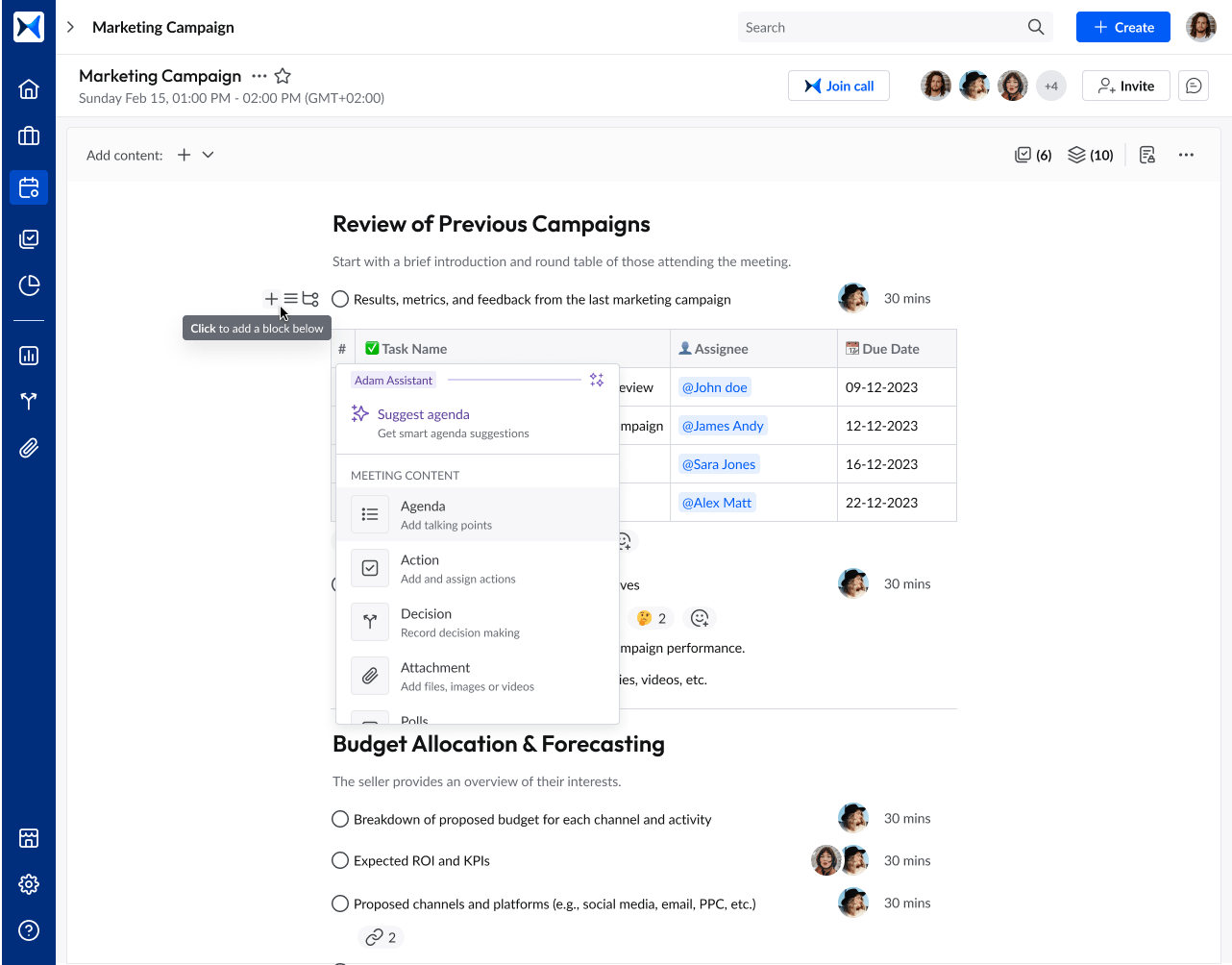
- Content collaboration: Securely share, review, and update compliance-related documents in real time, reducing miscommunication and ensuring everyone has the latest information.
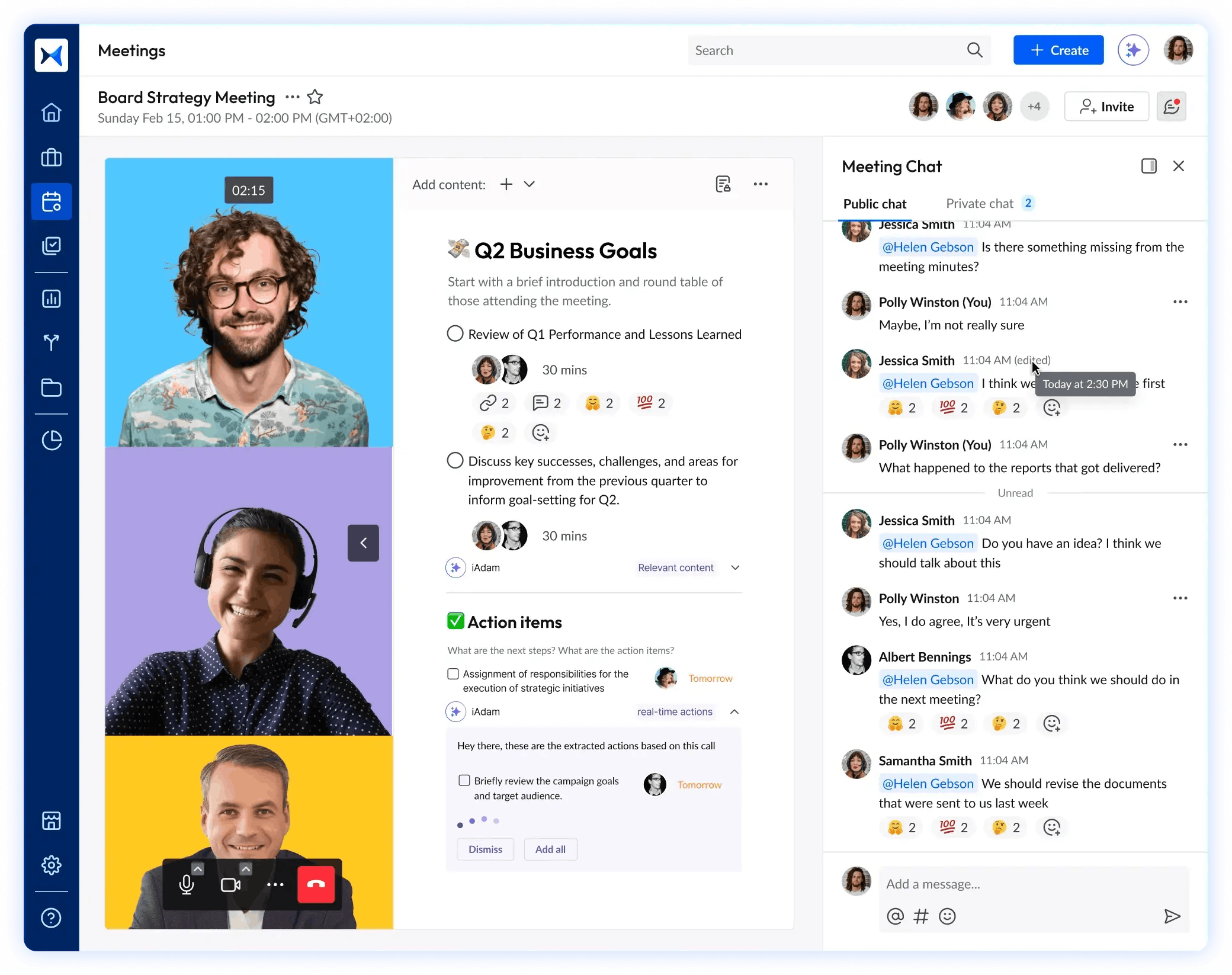
- Action tracking: Assign and monitor tasks directly from meetings, set deadlines, and link actions to compliance goals, ensuring accountability and follow-through on audit requirements.
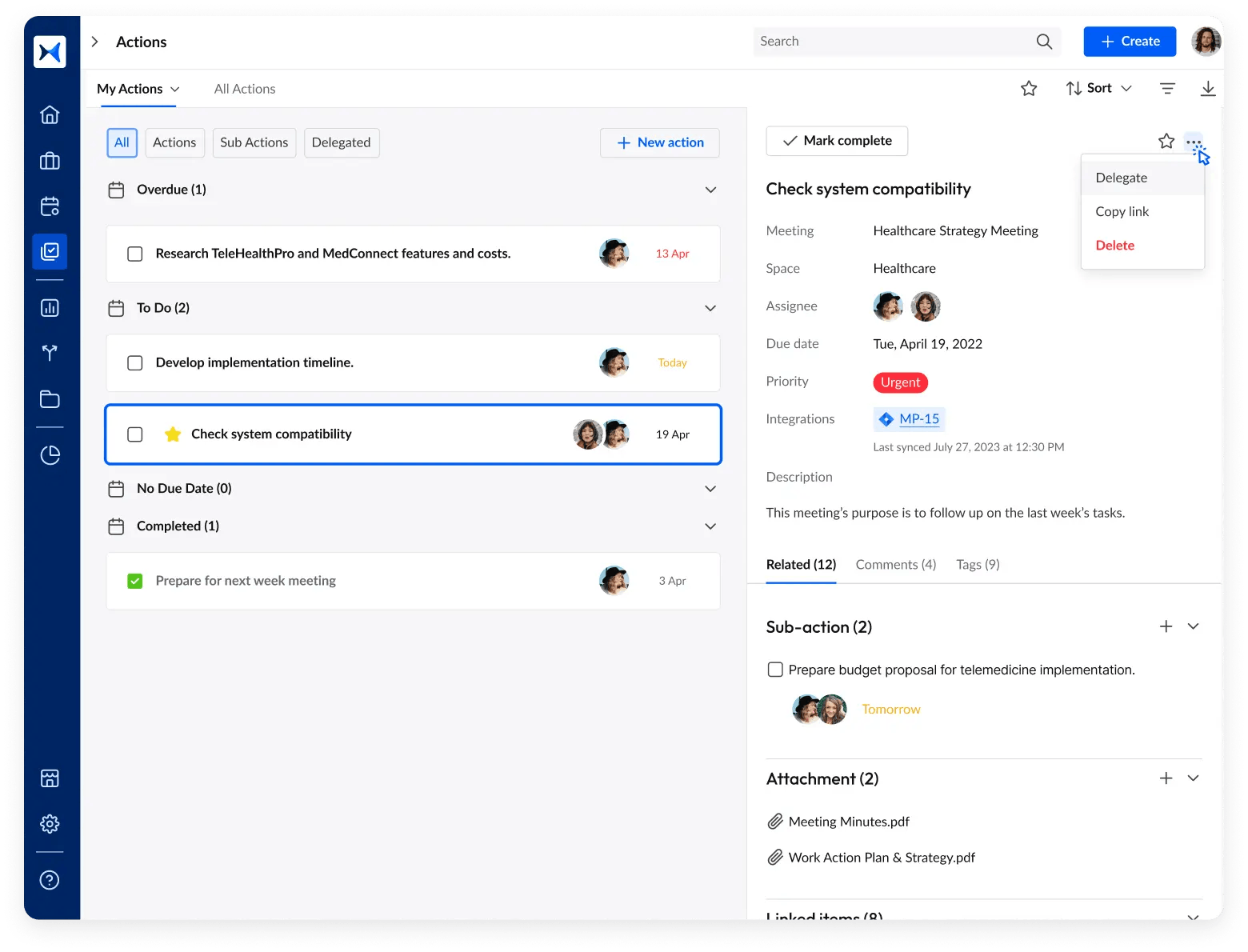
- Meeting minutes: Automatically capture discussions, decisions, and outcomes, providing accurate, organized documentation essential for audit readiness and regulatory reporting.
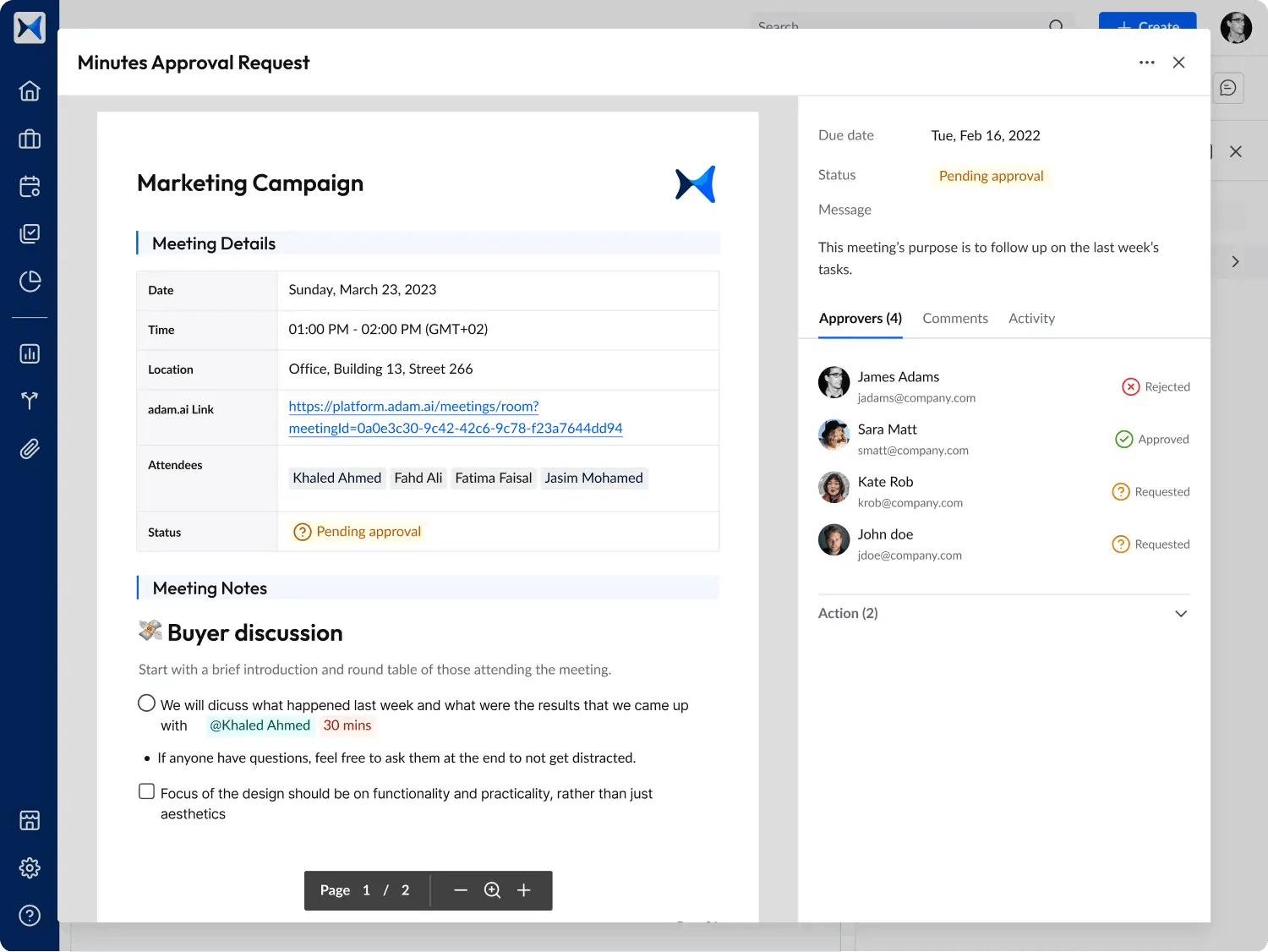
- Multi-space management: Organize meetings by department or focus area, such as compliance or clinical governance, while maintaining centralized oversight for effective coordination.
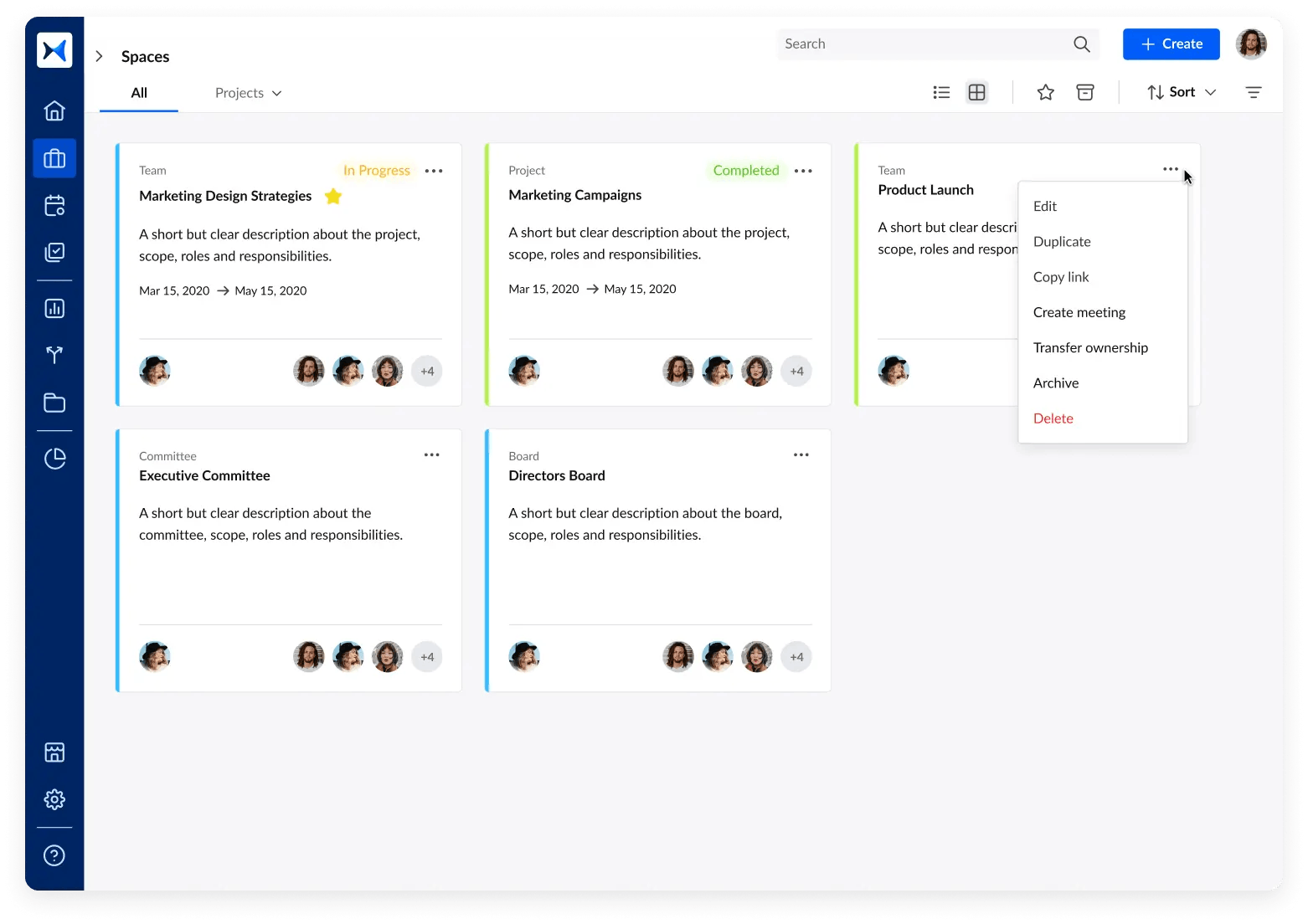
- Analytics dashboards: Gain real-time insights into compliance metrics, track task progress, and identify areas for improvement, enabling informed decisions and better audit preparedness.
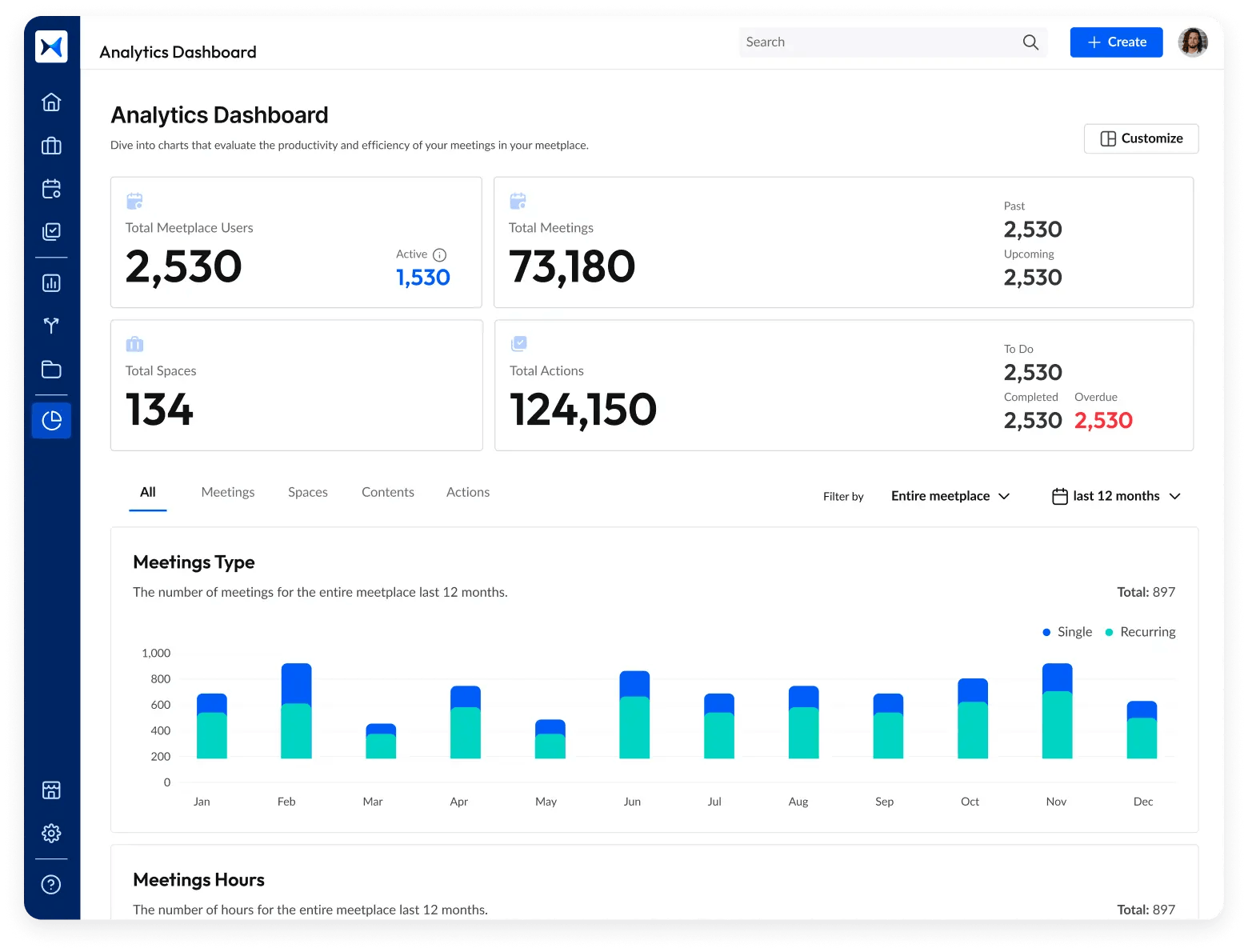
Transform how you conduct critical meetings—From meticulous preparation to effective execution and insightful follow-up, adam.ai integrates comprehensive analytics, full customization, and intuitive interfaces with powerful meeting management tools.
Easy onboarding. Enterprise-grade security. 24/7 dedicated support.
The bottom line
Optimizing compliance and audit meetings is essential for maintaining regulatory adherence and improving operational efficiency in healthcare. Modern tools can empower organizations to enhance these meetings, ensuring they are not only compliant but also impactful.
And while there may be multiple solutions available, here is why adam.ai is the meeting management software platform you can trust:
- adam.ai is one of Atlassian Ventures' portfolio companies.
- In the meeting management software category on G2, adam.ai has been ranked a leader and a high performer for successive quarters in the past years.
- adam.ai has been included in the Forrester Report in the AI-enabled meeting technology landscape.
- adam.ai is trusted and used by powerful teams and organizations worldwide for all types of critical meetings, like board, committee, project management, and business development meetings.
- And most importantly, adam.ai integrates with your existing workflow, is SOC2 compliant, provides dedicated support and success, and has a free trial option.
Subscribe to adam.ai blog
Stay ahead with the latest insights—get our newest blog posts, tips, and updates sent straight to your inbox.